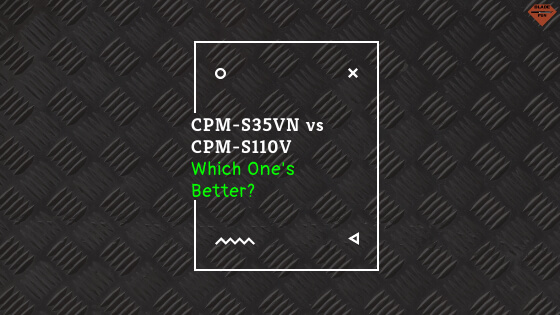S35VN (also called CPM-S35VN) and S110V (also called CPM-S35VN) are both great, high-end steels, but they each have their different uses. So, let’s check out the differences between the two.
Here’s the short version:
S110V is more of a specialty steel compared to S35VN. S110V holds an edge much longer, but is more prone to chipping, corrosion, and is harder to sharpen. S35VN is a well-balanced steel with better toughness, corrosion resistance, and ease of sharpening, but it doesn’t hold an edge as long as S110V.
That’s the short, surface-level version. There’s quite a bit more we can dive into, though. So… let’s do that!
Major Differences
The biggest differences you’ll notice between the two are toughness, sharpenability, and edge retention.
S110V is going to hold a longer edge, but as a tradeoff, will be harder to sharpen. Much harder to sharpen. It’s one of the toughest (if not the toughest) knife steels to sharpen. But, it can hold an edge for an extremely long time. It’s just a tradeoff.
Another difference between the two is toughness. S110V, while great at edge retention, lacks in the toughness department. S35VN doesn’t have as great edge retention, but it’s much tougher.
If you’re going to be doing anything aside from general slicing activities (like if you were going to be chopping a tree), then it’s better to go with the S35VN. If you are just going to be slicing stuff, then you’re probably going to have a better time with S110V because the edge will last a lot longer.
The corrosion resistance is one where you’re unlikely to notice much of a difference, but on paper, S35VN wins out slightly. So, if you need corrosion resistance and toughness, go with S35VN. If you really need corrosion resistance, go with something like H-1.
Another important difference is in price and availability. Generally, S110V costs a bit more and is harder to find. S35VN is usually cheaper and easier to find. It’s something to keep in mind if you’re going to be hunting for an S110V knife.
S110V
S110V, while labeled a premium steel, is mainly a specialty one. It’s something that you’re really only going to use if you need something that has insane edge retention for slicing activities–which, generally, are the kind of things that EDC’s (everyday carry’s) are used for.
S110V is made by Crucible Industries’ CPM process, which stands for Crucible Particle Metallurgy. It’s basically a process where the knife steel chemicals are more consistently distributed throughout the whole blade, meaning more consistent performance across the blade. The name S110V stands for “Stainless” (meaning it’s resistant to corrosion), the “model number” 110 (basically used to differentiate it between other, similarly named steels), and “Vanadium.”
Chemically, S110V has about 2.8% carbon, 15% chromium, 9% vanadium, 2.25% molybdenum, 3% niobium, and 2.5% cobalt.
Each of these do different things. The carbon helps with wear resistance and strength–though high amounts of it can actually weaken a blade’s strength. Chromium mainly helps with corrosion resistance. Molybdenum increases hardenability, which basically means that the blade hardens more consistently and is thus more consistently tough.
Vanadium and niobium both help to improve wear resistance and strength, with niobium helping just a bit more than vanadium. Niobium carbides (basically steel particles) are finer than vanadium, which helps to increase consistency across the blade and means that it can get a finer edge.
Cobalt also helps with improving the cutting edge. It helps to increase corrosion resistance and creates a slicker surface for smoother cutting.
Basically, S110V’s chemical combination makes it perfect for cutting and slicing activities. It’s the ultimate steel for holding an edge–hence why it’s a specialty steel: It can cut really well, but that’s about it.
If you’re interested in some knives with S110V, there are a few Spyderco’s out there with S110V blades, such as the Native 5 Lightweight and the Manix 2.
S35VN
S35VN is a much more common steel and it’s one of the few steels that are specifically made to be used as knife steels.
S35VN is an all-around solid knife steel. It’s extremely well balanced–the jack of all trades of knife steels, really. If you’re looking for a knife steel that can do pretty much all of it, S35VN is a good choice.
S35VN is also made by Crucible Industries with their CPM process. Similar to S110V, the name S35VN stands for “Stainless,” the “model number” to differentiate it from other similarly named steels, “Vanadium,” and “Niobium.”
Chemically, S35VN has about 1.4% carbon, 14% chromium, 3% vanadium, 2% molybdenum, and 0.5% niobium. Compared to something like S30V, it’s the slightly tougher older brother.
There are a lot more options out there for S35VN knives than there are for S110V. It’s a really widely used knife steel, so you’ll be able to find a bunch of options out there.
If you’re looking for a good one, the SOG Seal XR is a pretty slick option. It was made with operators in mind, so it’s got that tactical feel and can even be opened in reverse grip with your pinkie. If you’re interested, you can check it out here.
Basically…
If you’re looking for a more specialty knife steel with crazy edge retention to do a ton of slicing and cutting, go with S110V. If you’re looking for a super well-balanced knife steel that can almost do it all, go with S35VN.
If you’re interested in learning more about these knife steels and others, we’ve got a ton of articles on knife steel comparisons and profiles. You can check them out here.

